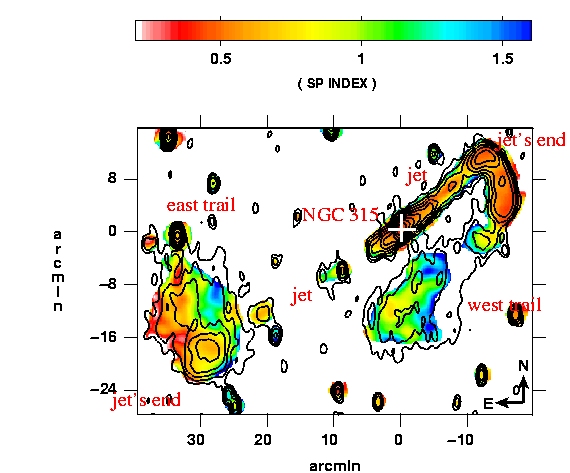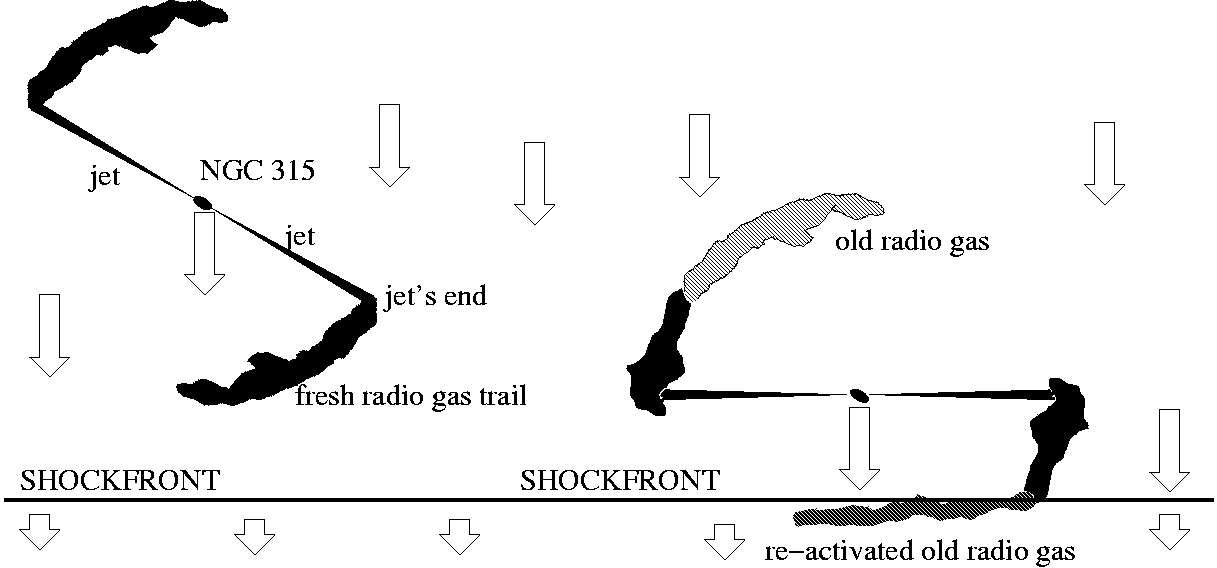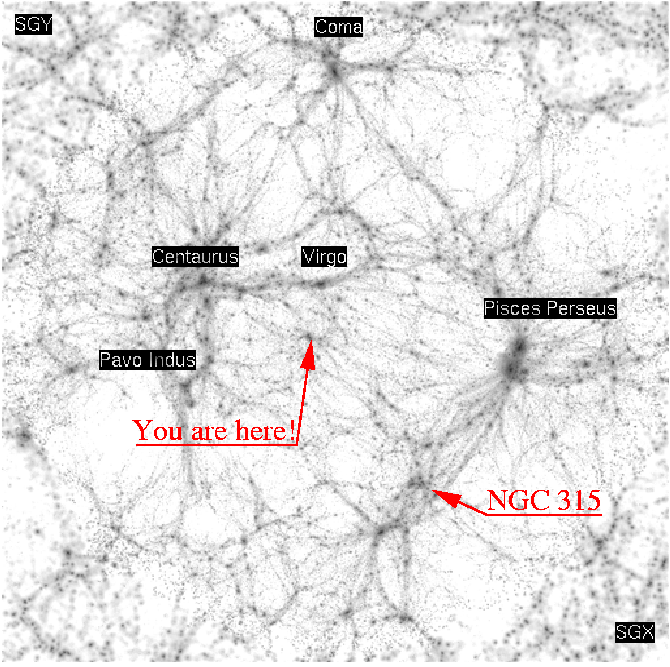Intergalactic Weather Station Reports Shock Wave |
Radio galaxies eject large amounts of radio emitting gas, which can exhibit a multitude of morphologies. These morphologies are shaped by the external `weather conditions' in a similar way as trails of smoke are shaped in the terrestrial atmosphere. Therefore radio galaxies can be used as `weather stations'. In the presented work the unusual shaped plumes of radio gas from the radio galaxy NGC 315 is serving as such a weather station in the several hundred lightyears long Pisces-Perseus filament of galaxies.
The giant radio galaxy NGC 315 is one of the biggest known radio galaxies due to its several million lightyears long jets of radio gas (see Fig. 1) . The gas presumably originates from the vicinity of a supermassive black hole in the center of the galaxy. It flows with high velocity within the diametrically directed jets into the intergalactic space until it gets stopped by the ram pressure of the environmental gas. Since the jet directions rotate (for some not completely understood reason), two giant radio trails are left behind the end points of the jets (Fig. 1 and 2). The western trail exhibits several peculiarities: It is bent, it is longer than the other, and it seems to be younger at its end compared to its middle part. These peculiarities can be explained by compression in an intergalactic shock wave: The crushing in the shock wave produces the bending, and the compression of the radio gas revives the radio emission and lets the gas appear younger than it is.
The proposed scenario assumes that at the present time the galaxy NGC 315 and the nearby intergalactic gas are falling into a shock wave. Only the front part of the western radio trail has yet passed the shock wave (Fig. 2) and therefore exhibits the observed peculiarities. An investigation of the galaxy distribution around NGC 315 reveals that the giant radio galaxy is located at a position within the Pisces-Perseus filament of galaxies (Fig. 3 and 4) at which several sub filaments hit the main filament. According to the results of simulations, and also according to the investigation of the galaxy distribution, one expects that gravitationally attracted gas collides there with a velocity of several hundred km/s with the main filament and forms shock waves. The peculiar morphology of NGC 315 therefore supports simulations of the formation of filaments and clusters of galaxies. Further it provides the first observational signature of the existence of giant shock waves in galaxy filaments.
Large-scale shock waves are the primary heat source in the wider intergalactic
medium, and they also allow measurement of its unknown entropic history.
They have been proposed as possible generation sites of intergalactic magnetic
fields, of ultra high energy cosmic rays, and of the diffuse gamma ray
background. Prior to this work, shock waves have been detected
only inside of galaxy clusters by temperature structures in the X-ray observable
cluster gas or by
radio emission from shock accelerated electrons. Here, the putative
shock wave is located in a galaxy filament, on a scale that is 10
- 100 times the dimension of a cluster and with a gas density that is orders
of magnitude lower.
| Figure 1: radio map of the giant radio galaxy NGC 315. | ||
|---|---|---|
 |
||
| The position of NGC 315 is marked by a cross. Two opposite oriented jets of radio emitting gas start in the center of the galaxy and become stopped after a few million lightyears by the collision with the dilute intergalactic gas. The stopped gas forms two trails, which exhibit the rotation of the jets orientations during the last 100 million years. The western trail (right) is significantly longer, it shows a bending, and seems to be younger than the eastern trail (left). The age of the radio gas can be derived by experts from the colour coded spectral index. The peculiarities point towards the presence of a shock wave within the intergalactic gas. | ||
| Figure 2: proposed szenario | ||
|---|---|---|
 |
||
| The radio galaxy NGC 315 and its ambient intergalactic gas are falling into a shock wave (left). Old, invisible radio gas is thereby reactivated by the compression in the shock wave. This explains the peculiarities of the western radio trail of NGC 315 (right). | ||
| Figure 3 : Pisces-Perseus filament of galaxies | ||
|---|---|---|
 |
||
| Galaxy distribution in the Pisces-Perseus filament of galaxies. Every cross marks the position of a galaxy in celestial projection (top) and seen from above in the so called redshift space (bottom). NGC 315 is marked by a read triangle. The galaxies of several sub filaments, which hit the main filament close to the position of NGC 315, are marked by colours. Distances are given in units of Megaparsec (ca. 3 million lightyears). | ||
| Figure 4: simulated cosmic neighbourhood | ||
|---|---|---|
 |
||
| Simulated distribution of matter in the `local' Universe. A volume
of 520 million lightyears length and 100 million lightyear depth is shown.
The position of our Galaxy, of several nearby clusters of galaxies, of
the Pisces-Perseus filament of galaxies, and of NGC 315 are marked. Details
of the simulation can be found
here . |
||
Further information:
| MPA-Home |
|